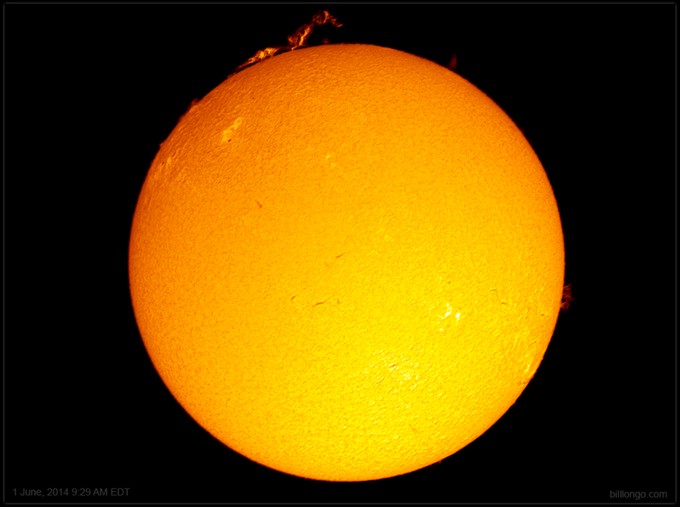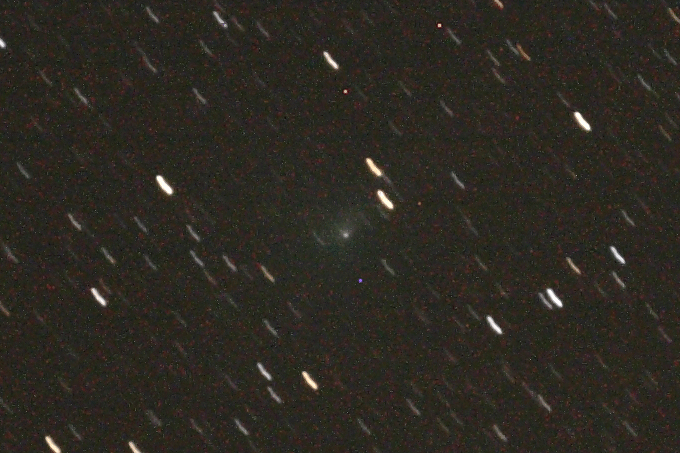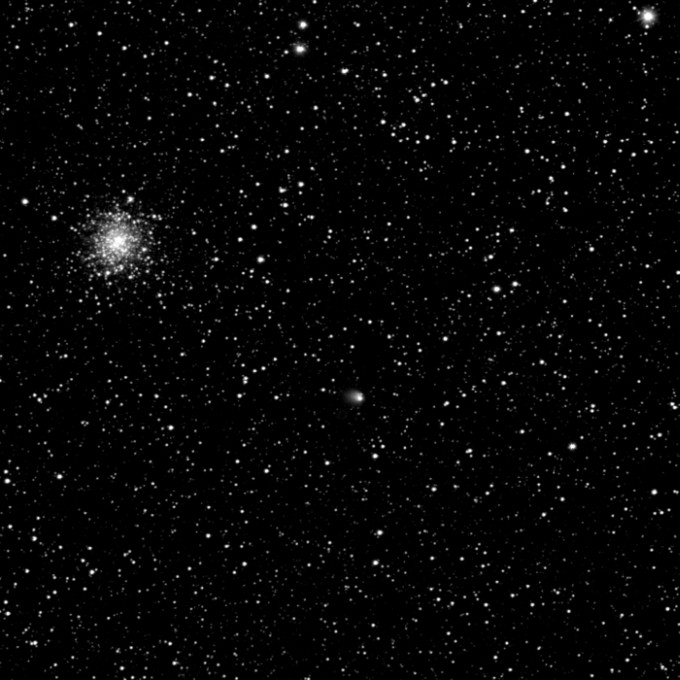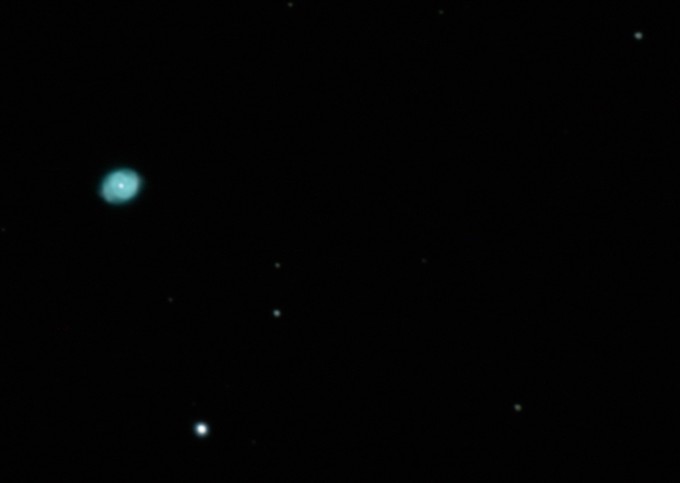The Sky This Month Jul 2014
A number of planets are visible this month including Mercury and Venus in the morning and Saturn after sunset. Asteroids Ceres and Vesta are moving apart but still fit in a binocular field. Comet C/2013 UQ4 (Catalina) is moving rapidly from Andromeda this month into Boötes. The ESA space probe is heading toward 67P/Churyumov–Gerasimenko to begin orbiting it late August. It will be very interesting to see a comet in action up close! The south delta Aquarid meteor shower will peak on Jul 29 just after the new Moon. Be sure to check them out as the Perseids will be washed out this year.
Blake Nancarrow delivered the following The Sky This Month presentation at the 9 July 2014 Recreational Astronomy Night Meeting at the Ontario Science Centre. The handout provided included a calendar for portions of Jul and Aug 2014. The notes have been reproduced here. You may view or download and print the colour calendar PDF file (320 KB). All photos copyright the respective owners.
big bodies
The Sun has been very active lately. During the weekend of Jul 5-6, a few of us were at the centre's Carr Astronomical Observatory on the Blue Mountains using the solar 'scopes. We took turns looking through the the Celestron 14-inch SCT with a baader filter and the Tele Vue 101mm with a hydrogen-alpha filter. We were blown away by the Sun's appearance. A half-dozen major sunspot groupings sporting large umbras with another half-dozen smaller formations were visible in white light. In H-alpha, a couple of large prominences were visible along the edge of the disc with many plages and filaments clearly seen. Not unlike Bill Longo's photo from earlier this year. Enjoy the views!

Sun as imaged and processed by Bill Longo on 1 Jun. (By the way, Bill received the RASC Ray Thompson award for photography the same evening the presentation was delivered. See Bill's web site for more astrophotographs.)
The inner most planet will be below the ecliptic until Jul 25 but the path of the planets is canted high in the morning for us. Mercury rises around 4:30 on Jul 10. It will be at the greatest angle or separation (elongation) from the Sun on Jul 12. While receding rapidly from us, it will brighten reaching magnitude 0 on Jul 17. Watch Mercury for a few nights noting the phase and size changes. It will be less than "first quarter" and 8.3 arc-seconds in size on Jul 10, almost full and 5.3" on Jul 31.

Point-n-shoot photo by Blake Nancarrow from Oct 2009. Venus is obvious. Below-left of Venus is Saturn. Below-left of Saturn, between the clouds, is Mercury.
Venus should dominate the morning sky, at magnitude -3. The second planet in the the solar system will dive-bomb Mercury around Jul 16. It will follow Mercury into Gemini on Jul 18.
An old Moon will arrive on Jul 24, catching and overtaking the planets. This will be a nice photo opportunity!

Spica, the Moon, and Mars by Patrick McDonald.
Mars is retreating and fading fast. Or rather, we're pulling away fast. Mars falls below mag 0.5 on Jul 24. That said, it is still an obvious orange in the evening sky, in contrast to nearby blue-white Spica. Another photo op.
Did you see Mars and the Moon on July’s first weekend? You'll get another chance early August. The first quarter Moon will be between Mars and Spica on Aug 2 then between Zubenelgenubi, Saturn and Mars on Aug 3.

The ecliptic and the constellations it touches. Saturn is in Libra, just left of centre. The image is a map plotted by Risa Horowitz for her "Imaging Saturn" project - the planet will pass through all these constellations during its 29.42 year-long orbit around the Sun. See Risa's blog article for more info.
The ringed planet is still offering tantalizing views. Saturn is very near alpha Librae for the next 4 weeks. It is fun to still see just a bit of the south pole beyond the rings. Have you been able to coax out Iapetus and Enceladus or the inner C ring? Saturn is near the meridian at 9 PM on Jul 10 while it is still light out. It will set around 2 AM on Jul 10; at 12:30 AM at the end of July. Another close pairing of the first quarter Moon and Saturn will occur on Aug 3 and Aug 4.
It stops moving retrograde on Jul 20. The rings are tilting more.
Uranus and Neptune are late-night and early morning targets.
small bodies
The minor objects Ceres and Vesta will put on a little show. Have you seen the "big asteroids?" Get out the binoculars and sketch pad! Watch them over successive nights and mark their positions relative to the background stars.
Chart produced in Stellarium. Object trails turned on. Simulated binocular view-of-field circle shown.
Both rocks are in Virgo, above Mars. Vesta overtook Ceres on Jul 4. (Thanks for the correction Chris Joly.)
The "first" asteroid 1 Ceres is around mag 8; 4 Vesta around mag 7. Both heading toward Saturn.
If you’re curious where the other big ones are: 2 Pallas by the way is over in Leo; and 3 Juno is in Orion.
comets this month
The comet C/2012 K1 (PANSTARRS) was interesting for a time but is now setting in Leo. It is around mag 7.2 and large but the sky is bright.
The new fun fast comet is C/2013 UQ4 (Catalina) which has been rising through Andromeda. While large it is mag 9.5. Tough to spot.

Comet animated GIF movie by Blake Nancarrow. Three frames shot approx. 2 AM on 6 Jul 2014. 3 to 4 minute subs with a 1 minute gap. Processed in Photoshop.
Download SkyTools finder chart for C/2013 UQ4. PDF format, 68 KB.
The European Space Agency Rosetta probe is on track for a rendezvous with comet 67P/Churyumov–Gerasimenko with orbit insertion, a mere 100km away, in the first week of August. The ESA probe is taking weekly images as it draws near.

Photo: ESA.
A small tail spotted early has disappeared. Already the comet is doing whatever it wants! Just like a cat.
The comet's aphelion distance is 5.7 AU so that means it would never be more than 6.7 AU from the earth. The comet-earth distance as of 2:01 PM 12/7/2014 was 408,100,728 km. I.e. 2.7 AU. (The term AU is a distance measurement. It stands for Astronomical Unit. It is the Sun-Earth distance or approx. 150 million km.)
Visit the Rosetta mission page at ESA for more info. Visit the wikipedia site for more info on the comet.
deeper sky
The Summer Triangle is just east of the meridian, the imaginary line from North to South travelling directly overhead, at midnight at mid-month. The constellations Aquila, Lyra, Scutum, Sagittarius, Cygnus, Vulpecula, Sagitta, and Draco are teaming with deep sky objects.
For variable stars, consider beta Lyr and the popular delta Cep. Keep an eye on gamma Cas. Some say it could pop up to mag 1.6! And maybe revisit M82 and Delphinus to the telltales of fading stars.
For doubles, try Zeta 2 CrB, Cor Caroli, and kappa Her. There’s 17 Cyg, 23 Aql, and Σ1878 (in Dra). Neat.
Red or deep orange stars are very interesting. Many are variables. Some are nearby dwarf stars. Look for mu Cep, La Superba in CVn, and Z Cygni near 26 Cyg.
Consider viewing confirmed exoplanet systems like 16 Cygni, 55 Cancri, and upsilon Andromedae. While amateur cannot (yet) see the planets directly around these stars, it is neat to view them knowing there are planets around the host star.
It is intriguing to note that many globular clusters huddle near the hub of the Milky Way. Visit M9, M14, M19, M28, M62, M69, M70, M80, and M107.
Many other Messier objects are visible this time of year. Want to try different, less common targets?

Cat's Eye planetary nebula by Blake Nancarrow.
For open clusters, try NGC 6633, NGC 6709, IC 4665. It’s planetary nebula season so find the Blue Racquetball, Turtle, Blinking, Cat's Eye, and Phantom Streak. Try the galaxies NGC 7331, NGC 5005, NGC 4605, and NGC 6384.
Also, it’s a great time of year to survey dark nebula. Soak in the Great Rift running from Cygnus to Sagittarius. Image from the tripod the Dark Horse Nebula, above theta and eta Oph. Zoom in on B 111 in Scutum. Enjoy the short dark skies, if you can.
measure the sky
The Globe at Night programme is kicking off another round of citizen science. Using Hercules between Jul 16 and 25, you can assess your sky, from the backyard, from the farm, from the cottage, wherever. And now you can use your smartphone, tablet, or computer.
measuring spaceweather
Canada's newest satellite is the CASSIOPE. Initial reports suggested it had trouble after launch; in fact, it is performing well.
See the Canadian Space Agency and University of Calgary web sites for more information.
watch the skies
Look up!

Photograph from February 2013 by Andrew Yee, friend of Chris Hadfield.
Orbital is launching the Antares this (or next) week for a resupply mission to the International Space Station. A Russian Progress is going uphill on Jul 23. An European Space Agency ATV is going up a couple of days later. Sounds like a busy place! You can see (and photograph) the ISS overhead in mornings starting Jul 18.
Set up a profile in the Heavens Above for all your preferred observing locations. Keep an eye on Chris Vaughan's Skylights for the best Iridium flares of the week. Did you know there are over 8000 man-made satellites in orbit?
end
Be seeing you. Contact Blake Nancarrow astronomy at computer-ease dot com for errors, omissions, questions.

